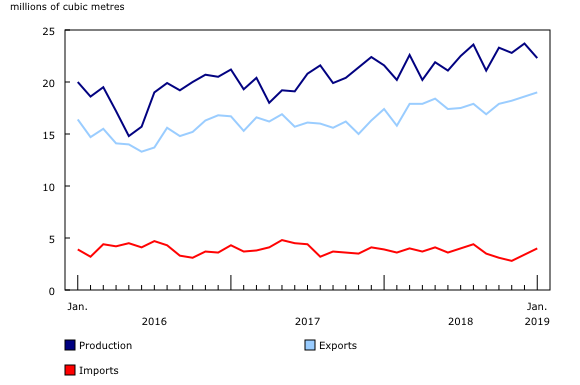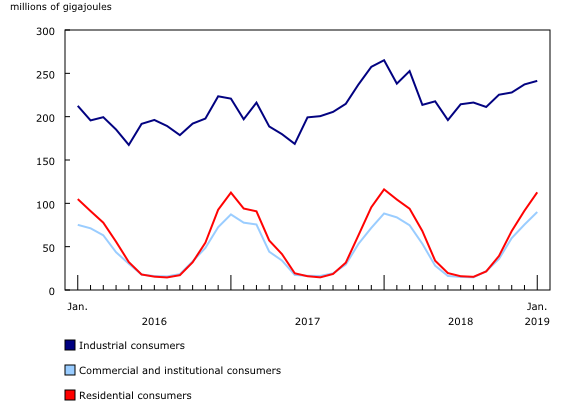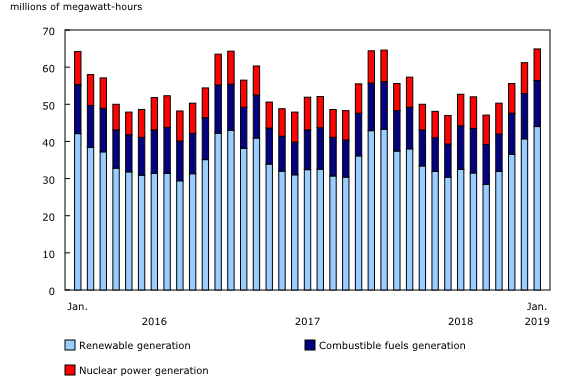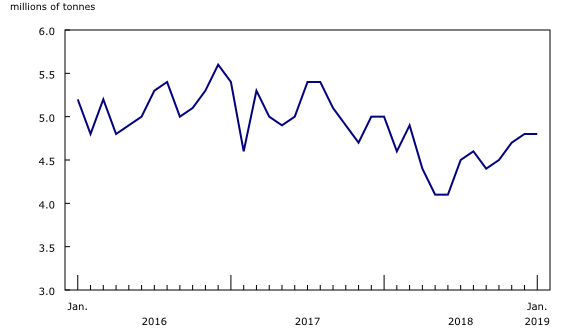Energy statistics, January 2019
Archived Content
Information identified as archived is provided for reference, research or recordkeeping purposes. It is not subject to the Government of Canada Web Standards and has not been altered or updated since it was archived. Please "contact us" to request a format other than those available.
Released: 2019-04-05
In January, crude oil and natural gas production and electricity generation rose, while coal production declined compared with the same month in 2018. Over the same period, exports of crude oil and equivalent products increased, while exports of natural gas and electricity decreased.
This release is a new product that combines a broad range of energy topics previously published individually in The Daily. Additionally, as of reference month January 2019, the questionnaire for the Monthly Refined Petroleum Products Survey program has been redesigned. For more information, see the note to readers.
Crude oil and equivalent products
Canada produced 22.3 million cubic metres (140.3 million barrels) of crude oil and equivalent products in January, up 3.1% from the same month a year earlier. January was the first month of temporary production cuts in Alberta. Compared with December 2018, Canadian production of crude oil and equivalent products was down 5.8%.
Production of crude bitumen was most affected by the temporary cuts. Bitumen production declined 7.3% compared with January 2018 to 8.0 million cubic metres. The decrease was offset by robust synthetic crude oil production, up 16.5% to 6.0 million cubic metres, while equivalent products (+9.4%) and light and medium crude oil production (+6.8%) were also up.
Heavy crude oil production totalled 2.0 million cubic metres, unchanged from the same month a year earlier.
Alberta produced 18.0 million cubic metres of crude oil and equivalent products in January, up 2.5% from the same month a year earlier, and accounted for 80.7% of total production. Alberta's production was 7.1% lower compared with December 2018. Saskatchewan (10.9% of total production) and Newfoundland and Labrador (5.6%) were also key producing provinces in January.
Pipelines in Canada received 19.6 million cubic metres of crude oil and equivalent products from fields and plants in January, down 12.4% compared with the same month in 2018. The vast majority of these receipts (85.7%) originated in Alberta.
Over the same period, pipelines delivered 7.9 million cubic metres of crude oil to Canadian refineries, down 2.1%. Of the total volume, 64.4% was delivered to refineries in the western provinces.
Exports of crude oil and equivalent products totalled a record 19.0 million cubic metres in January, up 9.1% from the same month a year earlier. The previous record of 18.6 million cubic metres was set in December 2018. Higher export volumes were partially the result of strong crude oil production reported in the previous month. Exports to the United States via pipelines rose 4.3% year over year to 16.1 million cubic metres in January. Overall, pipelines were the main mode of transport, accounting for 84.5% of total exports in January. Meanwhile, exports to the United States by other means (including rail, truck and marine) totalled 2.6 million cubic metres.
Over the same period, imports of crude oil and equivalent products increased 1.9% to 4.0 million cubic metres.
Refined petroleum products
Canada produced 3.1 million cubic metres of diesel fuel oil and 2.7 million cubic metres of finished motor gasoline in January.
Natural gas
Canadian marketable natural gas production totalled 607.9 million gigajoules in January, up 1.8% from the same month a year earlier. Production of natural gas was concentrated in Alberta (70.5%) and British Columbia (27.7%).
Over the same period, natural gas transmission and distribution systems delivered 241.3 million gigajoules to industrial consumers, 112.7 million gigajoules to residential consumers and 90.0 million gigajoules to commercial and institutional consumers.
Deliveries of natural gas in Alberta amounted to 198.5 million gigajoules in January. The majority (77.5%) were sent to the industrial sector, which accounted for 34.7% of all natural gas delivered in Canada.
Meanwhile, natural gas transmission and distribution systems delivered 137.7 million gigajoules of natural gas in Ontario. Of this total, 59.2 million gigajoules were delivered to the residential sector, which accounted for 52.5% of deliveries to residential consumers in Canada.
Opening inventory of natural gas held in Canadian storage facilities totalled 895.9 million gigajoules in January. During the month, inventory decreased 16.1% to 751.8 million gigajoules. This was the third consecutive decline in inventory as demand for natural gas increases during the winter.
Canadian exports of natural gas by pipeline to the United States declined 4.2% year over year to 297.9 million gigajoules in January.
Over the same period, imports to Canada from the United States by pipeline, which tend to be volatile, increased 31.3% to 108.5 million gigajoules.
Electricity
Electricity generation in Canada edged up 0.6% year over year to 65.0 million megawatt-hours in January. Renewable generation (including hydro, wind, solar, tidal and others) represented over two-thirds of the total (44.0 million megawatt-hours), while electricity generated from combustible fuels amounted to 12.4 million megawatt-hours, and nuclear generation totalled 8.5 million megawatt-hours.
By generation type, hydro was the single largest contributor to Canada's electricity mix, producing 40.2 million megawatt-hours of electricity. Quebec was the largest provincial generator of hydro-electricity in January with total production of 22.3 million megawatt-hours, followed by British Columbia with 5.8 million megawatt-hours.
Exports of electricity to the United States amounted to 4.9 million megawatt-hours in January, down 9.7% from the same month a year earlier. Quebec was the main exporting province (2.3 million megawatt-hours), followed by Ontario (1.6 million megawatt-hours). Over the same period, Canada imported 1.2 million megawatt-hours of electricity from the United States, with most of the imports going to British Columbia (0.8 million megawatt-hours).
Coal
Canada produced 4.8 million tonnes of coal in January, down 5.4% compared with the same month in 2018. Over the same period, coke plants produced 217.2 thousand tonnes of coke, up 10.1%.
Note to readers
As of reference month January 2019, Statistics Canada presents a new consolidated monthly release: Energy statistics. The survey programs which support the new release include:
- Crude oil and natural gas, supply and disposition (survey number 2198, tables 25-10-0036-01, 25-10-0055-01 and 25-10-0063-01)
- Pipeline transportation of oil and other liquid petroleum products (survey number 2148, table 25-10-0056-01)
- Supply and disposition of refined petroleum products (survey number 2150)
- Natural gas transmission, storage and distribution (survey numbers 2149, 5210 and 5215, tables 25-10-0057-01, 25-10-0058-01 and 25-10-0059-01)
- Electric power statistics (survey number 2151, tables 25-10-0015-01 and 25-10-0016-01)
- Coal and coke statistics (survey numbers 2147 and 2003, tables 25-10-0045-01 and 25-10-0046-01).
The tables associated with the above survey programs remain unchanged and will be updated as usual. Definitions, data sources and methods for each survey program remain available by accessing each survey's respective number.
As of reference month January 2019, the Monthly Refined Petroleum Products Survey has been redesigned. The questionnaire content has changed to reflect the evolving refined petroleum industry. Upgraders and petroleum terminals are now included in the survey frame. New variables have been added while other variables have been discontinued. Due to the change in methodology, the current estimates may not be comparable with the estimates available prior to January 2019.
As of reference month January 2019, tables 25-10-0015-01 and 25-10-0016-01 are available for the Monthly Electricity Supply and Disposition Survey. Electricity data from January 2016 to December 2018 have been revised.
The energy statistics program uses respondent and administrative data.
Data in this release are not seasonally adjusted.
Data are subject to revisions.
Contact information
For more information, or to enquire about the concepts, methods or data quality of this release, contact us (toll-free 1-800-263-1136; 514-283-8300; STATCAN.infostats-infostats.STATCAN@canada.ca) or Media Relations (613-951-4636; STATCAN.mediahotline-ligneinfomedias.STATCAN@canada.ca).
- Date modified:







